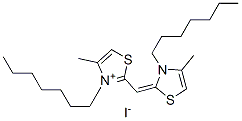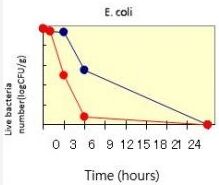●Acne care ●Anti-bacterial ●Anti-dandruff ●Deodorant ●Anti-melanin
| INCI Name | : | Quaternium-73 |
| Synonyms | : | 3-Heptyl-2-[(3-heptyl-4-methyl-3H-thiazol-2-ylidene)methyl] -4-methyl thiazolium iodide; Pionin; Bioxyne |
| 中文品名 | : | 季铵盐-73 |
| 别名 | : | 皮傲宁;感光素201;感光素201号;Kankohso 201; Pionin; Photosensitizing Dye No.201 |
| 日文名称 | : | クオタニウム-73; ピオニン |
| 韩文名称 | : | 쿼터늄-73, 감광소201호 |
| CAS No. | : | 15763-48-1 |
| EINESC/ELINCS No. | : | 239-852-5 |
| Molecular Formula | : | C23H39IN2S2 |
| Structure | : |
Quaternium-73 |
1. ANTIBACTERIAL ACTIVITY
Quaternium-73 shows extremely strong antibacterial activity at very low concentration. It damage the
microorganisms by causing collapse of cell membrane and cell wall and intracellular degradation.

Quaternium-73 is similar to cyanine dyes. Even a single Quaternium-73 molecule also has
anti-bacterial activity, which is the reason why Quaternium-73 is still efficient even with an extremely
low dose.
1.1 Fast and deep effect on anti-acne
Quaternium-73 has an excellent effect on Propionibacterium acnes. It is commonly used in Japanese
over-the-counter (OTC) as an anti-acne ingredient. Clinical research shows that it has a MIC= 0.00002%
for acne bacilli, and the rash can be reduced by 50% after two weeks of use.
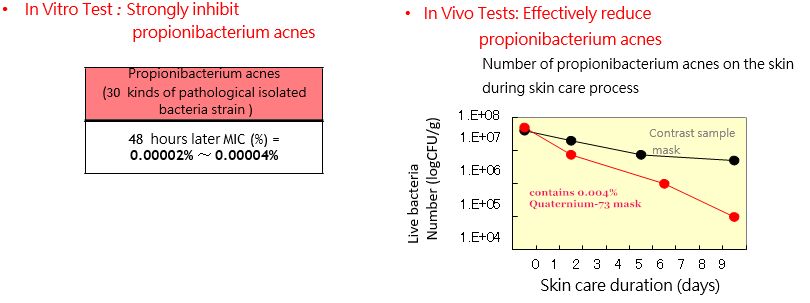
Clinical Test: Within two weeks, it reduced 50% spots
Testingprogram: Carry out test in 38 testees with acne problems
Method: Wash face 3 times every day withemulsion containing 0.001% of Quaternium-73 and smears twice a week with creamcontaining 0.005% of Quaternium-73.
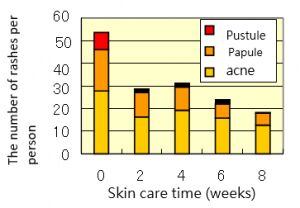
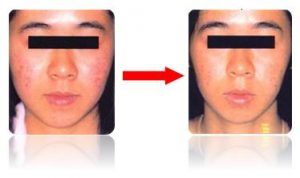
Anti-acne, whitening, anti-freckle
1.2 Bactericidal activity
The Quaternium-73’s bactericidal ability allows it to be used as a preservative. In vitro test data shows that
in term of anti-bacteria and anti-fungi of various kinds, Quaternium-73 is more effective than paraben
methyl ester. Therefore, just adding a small amount of paraben in the formulation containing
Quaternium-73 is enough to achieve an antibacterial effect.
| Bacteria Category | MIC
(%) Methylparaben | MIC
(%) Quaternium-73 |
| Escherichia
coli | 0.125-0.4 | 0.005 |
| Pseudomonas | 0.1-0.4 | >0.01 |
| Staphylococcus | 0.16-0.4 | 0.005 |
| Candida | 0.1 | 0.001 |
| Aspergillus | 0.08-0.27 | 0.005 |
● Quaternium-73 can be used the number of E.coli contained in 0.002% quaternium-73) | ●Quaternium-73 can compensate for the methylparaben (Adding 0.002% quaternium-73 can lead to an increase of anti-E.Coli activity of | ● When mixed with polyols, Quaternium-73 can completely |
| 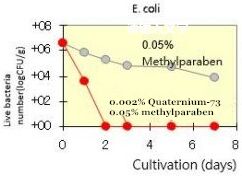 | 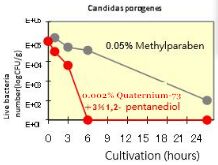 |
1.3 Inhibits bacteria and fungi with an extremely low dose of use ( In vitro test )
In vitro test (see table below, agar plate dilution) proves that the extremely low dose of use of
Quaternium-73 can also inhibit a wide range of bacteria and fungi. The lowest concentration of
Quaternium-73 used to inhibit bacterial growth is called the Minimum Inhibitory Concentration (MIC).
Bacterial names MIC % Fungi names MIC %
Liquid achromobacter sp 0.001 Absidia orchidis 0.0001
Enterobacteriaceae 0.01 Tinea capitis fungus 0.001
Botulinum toxin 0.005 Black aspergillus 0.005
Escherichia coli 0.01 Aspergillus flavus 0.0005
Brown flavobacterium 0.001 Candida albicans 0.001
Proteusbacillus vulgaris 0.001 Epidermophyton floccosum 0.0001
Pseudomonas aeruginosa 0.1 Gypsum-like microsporum 0.0001
Salmonella enteritidis 0.005 Soft rot rhizopus nigricans 0.001
Staphylococcus aureus 0.0005 Saccharomyces sake 0.001
Staphylococcus citrate 0.001 Zygosaccharomyces 0.0005
2. STRONG INHIBITION OF MELANIN
In vitro test indicatesthat:
0.000003% Quaternium-73can suppress 50% melanin formation
0.00001% Quaternium-73can suppress 83% melanin formation.
In contrast, 0.07% kojicacid can inhibit 100% melanin formation.
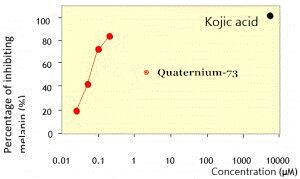
3. HIGHLY SAFE AND NON-IRRITANT
◇ Human body patch test ( human body, 0.2%, 48 hours ): negative
◇ Initial skin irritation ( rabbit, 0.2%, 24 hours ): negative
◇ Sustained skin irritation ( rabbit, 0.01%, 90 day ):negative
◇ Eye irritation ( rabbit, 0.0007%, 24 hour ): negative
◇ Skin sensitization ( Guinea pig, 0.2%, maximum test ): negative
◇ Phototoxicity ( rabbit, 0.2%): negative
◇ Photosensitization ( Guinea Pig, 0.2%, Adjuvant-Strip Method ): negative
◇ Induced gene mutation (10μg, Ames test, ±S9 mix): negative
◇ Acute Toxicity LD 50 ( mouse ):325 mg/kg; LD50 oral rat: 460mg/kg
4. FORMULATION GUIDELINES
Recommended dosage 0.001-0.005%
Stable pH 5.5-8.0
Good thermal stability Up to 90ºC
Solubility Soluble
in butylene glycol, propylene glycol, ethanol, 1,2– pentanediol.
Slightly soluble in water (0.6068mg/L @ 25°C (est)).
Operation guide It is recommended to pre-dissolve quaternium-73 in butylene glycol, propylene
glycol, or 1,2– pentanediol before adding. The dissolution can be accelerated by the aid
of boiling water bath.
Photostability Unstable; cosmetic products containing quaternium-73 need to be canned in opaque
containers.
5. APPLICATIONS
Quaternium-73 can be used in Cleaning products (facial cleanser, shampoo); Acne products, Oily skin care
products; Whitening products; Synergist as preservative
6. REGULATORY STATUS
Compliant with Japanese Quasi Drugs to be used in anti-acne products; China Compliant
7. HANDLING AND STORAGE
Stored in a cool, dry, dark place.
Special care is taken to prevent the powder from diffusing into the air. Wear a mask to avoid inhaling powder.
After use please wash your body, hands, mouth and face thoroughly.
8. SPECIFICATIONS
Appearance : Light to yellow crystalline powder
Purity (HPLC) : ≥99.0%
Melting range : 224-228ºC
Loss on drying : ≤0.5%
Heavy metals(Pb) : ≤10ppm
Bacteria : <500cfu/g
Mold and yeast : <100cfu/g
Escerichia coli : Negative
Documentation:


